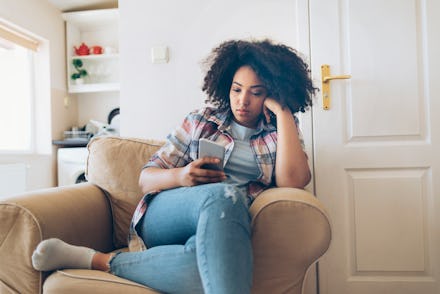Are guided breathing apps a drug-free way to tame anxiety?

The psychological and physical symptoms of my generalized anxiety disorder tend to feed on each other: An anxious thought rears its nasty head, quickening my heart rate or tightening my stomach — which only further fuels my anxiety. One strategy I’ve employed to break this cycle is to watch a simple, yet oddly effective YouTube video of a triangle blooming into a series of concentric shapes, over and over. I time my breathing to the blooming, visualizing my lungs expanding and contracting. As my breathing deepens, I feel myself begin to relax. In fact, a number of meditation apps also use visual and other cues to help people slow and deepen their breathing in order to manage their anxiety and prevent panic attacks.
How can something as simple as deep breathing help stave off a panic attack? In the moments leading up to a panic attack, you might notice your breathing start to feel constricted and concentrated in the upper chest, explains L. Rebecca Connell, a therapist with an independent practice in Oakland, California, known as the Center for Stress Reduction. You tend to feel deep breathing, on the other hand, in the abdomen, and you often engage in it when you feel relaxed and safe.
But while some people might benefit from trying to control or change their breath, Connell says, the strategy could backfire in others, making them more worried about their breath, which could worsen their anxiety. More important than attempting to breathe a certain way is to gently notice your breath and treat yourself with compassion, whatever form your breath takes — whether fast or slow, shallow or deep. Practicing this mindful approach when you're relatively calm could make it easier for you to do so when you're anxious, and before your anxiety escalates into a full-blown panic attack.
Meditation and guided breathing apps can be helpful in moments of mild to moderate anxiety, when it’s harder to hear your own inner guide, Connell says. But she worries that without guidance from a mindfulness teacher, you might set unreasonable expectations about how you “should” feel — for instance, that you need to empty your mind — which can make you feel discouraged and, again, worsen your anxiety. If you have periodic feelings of anxiety without panic attacks, these apps could be useful, but “if someone is having panic attacks, especially if they’re worried about having another one, they might want to find a licensed professional who can work with them,” she says.
That said, here are a few guided deep-breathing-focused apps to check out:
Calm
Free with in-app purchases and compatible with most Apple and Android devices, this meditation aid offers a customizable, visually-guided breathing exercise, the Breathe Bubble, which resembles the animation I mentioned earlier. Calm’s website offers a stripped-down version, which displays a bubble that bears the instructions “Deep breath in” as it expands. The instructions then switch to “Long breath out” as the bubble contracts. You can even edit the breathing pace by using a slider to set the number of breaths you draw per minute. In a recent clinical trial of Calm in college students, most participants said the app helped lower their stress, and that they would use it again.
Insight Timer
Available for Apple and Android devices, Insight Timer ranks as the “#1 free app for meditation and sleep,” with more than 10 million users, according to the app’s website. (Although free to download, it also includes in-app purchases.) You can listen to audio tracks of thousands of guided breathing meditations led by Thich Nhat Hanh, Sharon Salzberg and other renown mindfulness teachers. The app also allows you to see meditators in your area, as well as how many others were meditating at the same time as you, Mindful points out, making you feel like part of a larger community.
The Breathing App
The Breathing App is probably the most customizable deep breathing app on the list. The free, Apple- and Android-compatible app lets you set the length of your guided breathing meditation, as well as your inhalations and exhalations, and whether you want an audio or visual cue. If you prefer a visual cue, you can chose a pulsating gray ball or a ticking clock. But if you prefer an audio cue or just want to keep your eyes closed, you can use the “sound breath guide,” which plays one sound that cues you to inhale, and another that cues you to exhale.